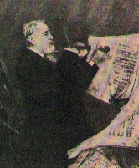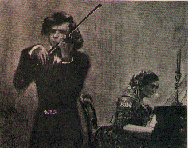
Joseph Joachim was born in 1831, the seventh of eight children of a Hungarian Jewish family from Kitsee, Hungary. When he was four, his father gave him a toy violin which caused Joseph such delight that it was decided to allow him to study the violin. After a public performance of a double concerto by Eck with his teacher, a local violinist by the name of Serwaczynski, he was sent by the suggestion of the virtuoso Ernst to Vienna to study with the also Hungarian Joseph Boehm, Ernst’s teacher.
After four years in Vienna, Joachim was sent to Leipzig to enter the Conservatory there. In his entrance examination by Felix Mendelssohn, he was told that he needed no conservatory; he was told instead to play for Ferdinand David on occasion, study composition, and play with Mendelssohn, in addition to getting a general education. This was done. Mendelssohn was a great influence in the young Joachim’s musical development, bolstering his admiration and respect for the works of the great composers, freed his musical outlook, and gave him many valuable performance opportunities.
The young violinist’s fame grew and spread rapidly, bringing him to such renown that he was asked to play Spohr’s Seventh Concerto at a concert honoring the composer, where Spohr described Joachim’s playing as “quite masterful.” His rapid progress was fortunate, because at about this time came the death of Mendelssohn, and Joachim was forced to stand on his own.
Also at about this time, Joachim bacame a friend of the Schumanns, Robert and Clara, with whom he was to continue in friendship and mutual admiration, a favoured interpreter of his works and a trusted friend of hers even after the breakdown and early death of her husband. This association formed a counterbalance to his work at the same time at Weimar, where he went, leaving Leipzig to become Liszt’s concertmaster. Though he was at first a fairly avid admirer of the modernistic activities there, his training as a classicist finally won out and he moved on to Hanover, where he was royal music director.
At Hanover, Joachim’s duties included not only playing as concertmaster but conducting as well, and he was given sufficient time to expand his touring schedule. Among his performances at this time was a performance of the Beethoven Violin Concerto under Schumann’s direction at Düsseldorf as a part of the Rhenish Music Festival. Clara Schumann considered this, according to her diary, as a great triumph, an unforgettable performance beyond any other virtuoso she had heard. He also met the young Johannes Brahms, sending him with an introduction to Robert Schumann, who hailed him as a new musical Messiah.
Robert Schumann, though, was in the last few years of his life and indeed in the last year in which he would compose. He spent much time that year, however, working on two new works composed with Joachim in mind, the Fantasy for violin and orchestra and the Violin Concerto. Though Joachim played the premiere of the Fantasy, the concerto remained unperformed and unpublished because the composer’s mental problems prevented his revising it as planned. After his death, Clara Schumann, Joachim, and Johannes Brahms decided together to omit the concerto from the collected works edition of Schumann, feeling it to be an injustice to Schumann’s memory. It was, indeed, not performed publicly until 1937, by Georg Kulenkampff, when it was hailed as a great work and a missing link between the Beethoven and Brahms concerti.
During the time he spent at Hanover, Joachim became much more well- known as an international performer. He traveled to England increasingly often until it became a yearly event; in fact, England became a sort of second artistic homeland for Joachim. He gave his Viennese debut to critical acclaim, playing his Hungarian Concerto , which did not find equal critical approval, though many of his contemporaries expected it to gain a permanent place in the violin repertoire. Joachim also began to assemble a group of students, to whom he taught not so much technical details as his own approach to music.
Joachim left his post in Hanover in 1865 and moved to the newly- established Berlin Hochschule, where he was the violin professor until his death forty years later. He there established the renowned Joachim String Quartet, which was one of the first established string quartets to give public concerts, premiering the works of many of their contemporaries. His students became the foundation of an individual Berlin school of violin-playing, under the direction of Joachim and his assistants, most notably Emanuel Wirth and Andreas Moser, who dealt mainly with the students’ technical development. Joachim himself gave little or no actual technical instruction to his students, applying himself more to interpretative art.
Until about four months before his death, and making Joachim continued concertizing and editing the Bach solo sonatas with Moser. The passed his seventy-sixth birthday ill, and after an operation, died in Berlin on August 15, 1907.

Joachim’s attitude as a musician toward music was that of a servant; he had since his youth treated the works of the masters with great respect. His interpretations were described as coolly and reservedly intellectual, but also deeply spiritual and with a certain freedom. He championed music of earlier composers such as Bach and Beethoven, with whose music he was closely identified, as well as his contemporaries, particularly Schumann and Brahms. His rendition of the Beethoven Concerto rescued it from undeserved obscurity, establishing it in the standard violin repertoire as one of the greatest jewels. Indeed, Joachim was one of the first great violinists to be foremost an interpreter of the works of others; most of his predecessors had been, like Paganini, specialists in the performance of their own works.
Joachim’s tone, as evidenced from his recordings and descriptions by his contemporaries, was not at all large, but very pure and cool. The bow grip he used, with the fingertips close together and perpendicularly placed on the stick of the bow almost at their tips, though it did not allow a weighty tone, did give minute control over the dynamic nuances and subtle shadings of tone for which he was renowned.
In keeping with his great reserve, Joachim’s vibrato was extremely controlled; at many, even most, times, he employed no vibrato at all. When he did use it, it was a mere quiver, originating from the fingers of the left hand, and not at all the emotionally pulsating vibrato of a Kreisler or Ysaÿe. The same unsensuousness extended to the portamento. Joachim and his disciples seldom, for their time at least, slid as excessively as others, say a Sarasate or Hugo Heerman.
As Joachim aged, his playing deteriorated. His tuning became much less accurate, his dexterity less, and the purity of his tone decreased, a certain scratchiness and crunching entering it. It is for this reason that we must not take his few recordings, made only a few years before his death, as a final view of his playing style. They exhibit many failings of intonation and occasionally execrable tone, familiar from this excerpt from a probably much exaggerated review by George Bernard Shaw of a performance of a Bach Solo Sonata:
Now that he is on the verge of sixty he keeps up the speed at the cost of quality of tone and accuracy of pitch; and the results are sometimes, to say the least, incongruous. . . Joachim scraped away frantically, making a sound after which an attempt to grate a nutmeg effectively on a boot sole would have been as the strain of an Aeolian harp. The notes which were musical enough to have any discernable pitch were mostly out of tune. It was horrible - damnable! Had he been an unknown player, . . . he would not have escaped with his life.
Today’s players are influenced by Joachim mainly through his pioneer performances and editions of the great violin works and the cadenzas he wrote for them, as opposed to any technical influence. His technique was suited only to him; when passed on to students by his assistants, it was very tense and cramped. His low right elbow and lateral wrist movement at the bow change (one of his assistants was known to his students as the Handgelenkler, delightfully translated by Boris Schwarz as “wristler”), though effective in his playing, was unsuited to most physiques and produced what Karl Flesch referred to as violinistic cripples for life. Of course, Flesch was given to judge all ways of playing of which he was not an adherent as crippling.
Joseph Joachim was the culminating figure of the nineteenth century. With his death in 1907, the stage was set for violinists such as Eugene Ysaÿe, Fritz Kreisler, and others, who would combine the technical ability of the “display” virtuosi such as Sarasate and Vieuxtemps with the depth of musicianship exhibited by Joachim and his ilk.
Email me with suggestions or comments